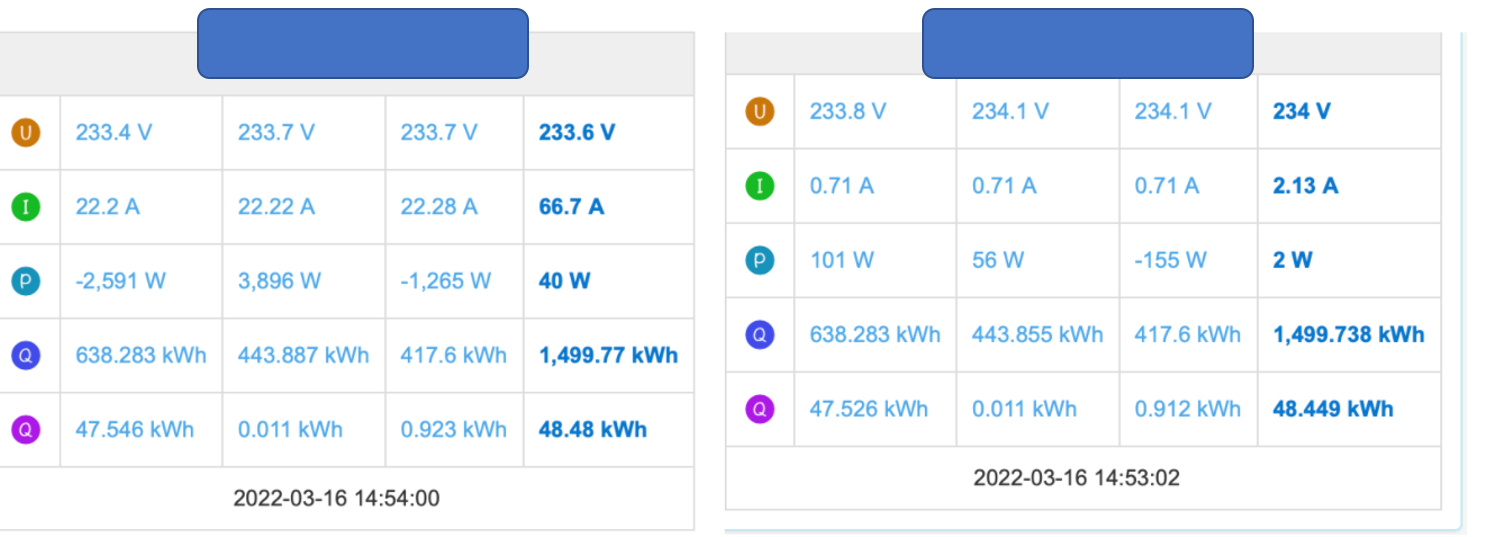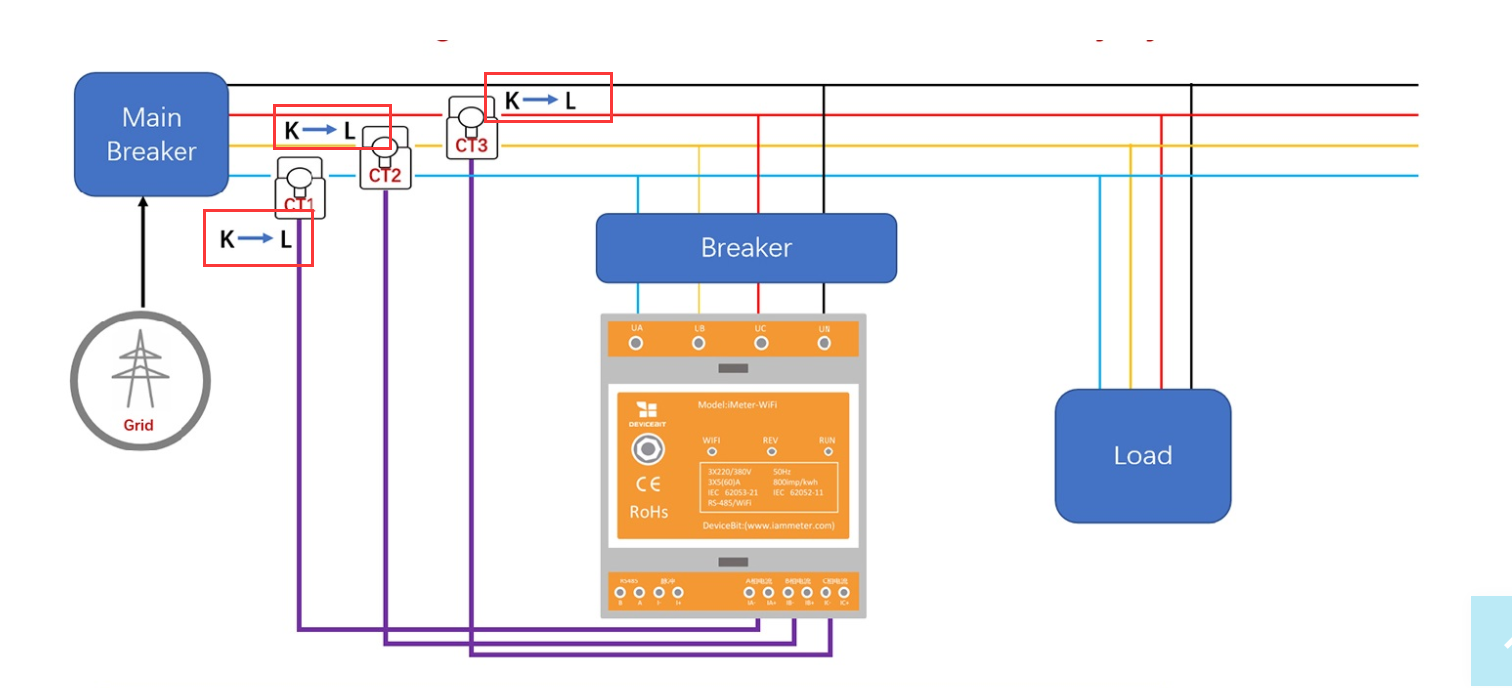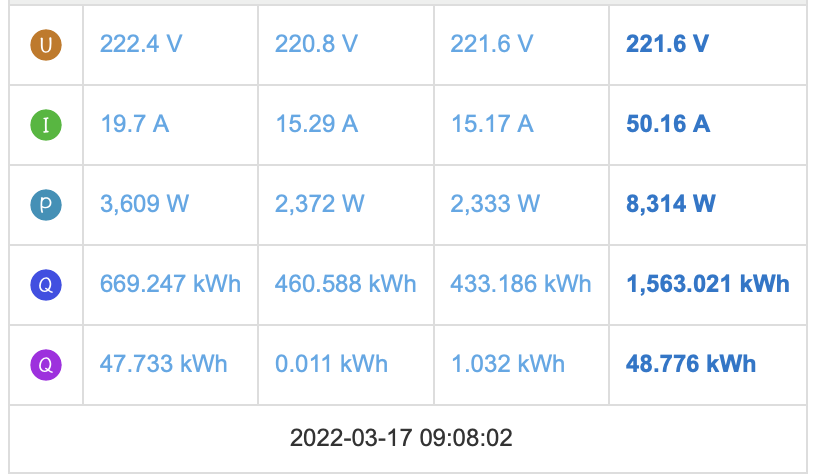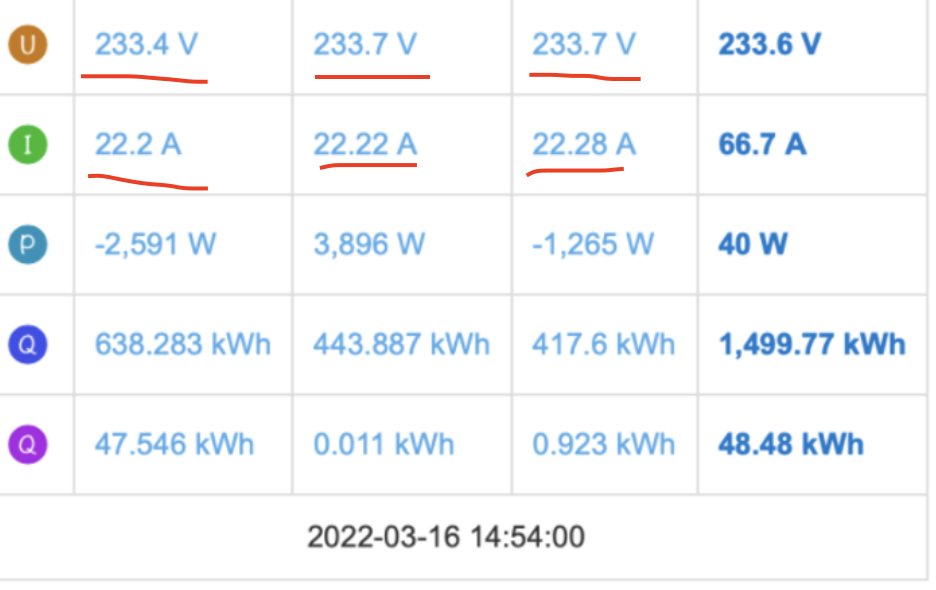Wem3080T ampere reading are wrong.
Wem3080T with 150A clamps giving ampere reading not accurate. Testing phases with ammeter clamp result 20% lower than wem3080T clamps.
Checked cables connections and all is connected correctly.
Is there a way to calibrate the clamps maybe?
The promised accuracy of this energy meter is class 1. it means the maximum error in reading will be within 1%.
Please do not hurry about considering the calibration.
As far as I know, this product has not met the accuracy problem until now(except the ct is damaged during the shipping). In fact, all the so-called accuracy problems that reported to us before had been proved is just the problem of usage or understanding.
You can do this testing below.
Clamp all three phase CT in the same wire and check whether the ampere reading of all three phase are nearly the same. If so, it will prove the consistency of the three phase ampere reading. if the consistency has been proved, the accuracy will be also proved.
If there is an ampere reading of one phase has a dramatic difference from others. it indicates a problem(maybe the ct is damaged during the shipping).
If all three phases ampere reading is nearly same but their reading has an obvious difference from your device, it may be such reasons.
1 use a multimeter to calibrate the energy meter.
Please let me which equipment have you used to "calibrate" the amp reading of the WEM3080T? if you used the multimeter with clamp input, its accuracy is much lower than our product, so it can not be used in calibration.
2 Compare the ampere reading of different time points.
Because the WEM3080T uploads data each 1min, if the ampere is changing frequently(not constant), the device you have used to calibrate can show the real time changes, but the WEM3080T can only display the ampere in 1 min interval.
Then the comparison that not at the same time point will also bring a obvious difference.
Hi and thank you for the quick answer.
I have to order plenty of your devices, so I need to solve this issue first.
As you suggested I will make the "three clamps in same phase" test ASAP to check if the 3 clamps are ok, but the differences that I found are in all three phases and not only one, tested it with 2 different brands "multimeter clamp" devices.
The 2 multimeters (different brand: one is a cheap device and the other a professional one) read the same ampere values so I suppose this is the "real" consumption value.
When the wem3080T read 20 ampere, the two multimeters read 16 ampere, the same difference is in the all phases.
I have also considered the 1 minute refresh so I checked the value when the device refreshes of course.
what you mean with "calibration" ? is there a way to calibrate the device with the multimeter? I can't find anything in the manual about that.
thank you again.
I made the test putting the 3 clamps in the same phase cable.
The read was same values in Ampere and the same Volts, but what I noticed is that the WATT are different and its a weird result as WATT should be VoltxAmpere but the result is totally different value.
for example I read 233V and 22.2A but the Wats are A: 2,591 W | B: 3,896 W | D: 1.265W
Hi, this question is very typical, let me use this thread to introduce how to confirm the reading accuracy of the energy meter by a simple method.
1 How to confirm the accuracy of the energy meter by a simple method?
Test the consistency of the three-phase energy reading is a simple method to prove the accuracy of the energy meter.
As I described above, clamp all three-phase CT in the same wire ,connect all three phase voltage inputs (UA,UB UC) together and power them in one phase voltage.
Then you can compare all three-phase reading(voltage, current and active power), if they are all nearly the same, it means the consistency of all three-phase reading are well.
In this case, it is a very low possibility that the accuracy has a problem.
2 what is the problem when you test the consistency of the energy meter?
This is the snapshot you provided in email(I have hidden the SN), from these pics, there are two obvious problems.

1 The CT direction is wrong in your testing. The energy meter is bi-directional, so there is a direct requirement when you clamp the CT on the wire.
There is a K->L mark in the CT, and when you clamp the ct on the wire, you need to confirm the K->L direction is the same as the below pics.(https://www.iammeter.com/quickstart/wem3080t-quickstart#2-typical-wiring-diagram)

You can consider that the direction of K->L should be the same as the current direction.
If you install the energy meter on grid side and there is no solar PV inverter in your system, the power value should be always positive. From the snapshot, there is a negative power value in phase A and phase C, which means that CTa and CTc had been installed in the wrong direction. So please change the installation direction of CTa and CTc.
2 You have not connected all three phase voltage input(Ua, Ub,Uc) together when you test the consistency.
Although the voltage reading is nearly the same from your snapshot, but it is obvious that you have not power the Ua Ub and Uc by only one phase voltage but three phase voltage .
The power measured is an active power, not the apparent power(apparent power = U*I).
The formula of the active power is: active power = U*I*Power factor
power factor =cos(phase angle between voltage and current)
In a normal situation, the phase angle between current and voltage in each phase is from less than 90 degrees (nearly zero in good performance). so the active power is always positive.
But there is 120 degrees phase difference between each phase.
So if you clamp the CTa on the wire of phase B but still power the UA by the voltage of phase A, the active power will be calculated totally wrong.
In conclusion,
1 please change the CT direction of Phase A and phase C .
2 connect Ua Ub and Uc together, power them with the same phase voltage.
For example, If all three ct are clamped on the wire of phase B, then power Ua Ub and Uc also in the voltage of phase B.
After doing this two correction,
you will see all three phase reading(voltage, current, active power ) is nearly the same, then it will prove the consistency of the three phase reading.
After you have confirmed the consistency of the three-phase reading, If you need,we can also help you find out why there is an obvious difference ampere reading in multimeter and our energy meter.
The possible reason must not be the accuracy(after the consistency had been proved), but some other reasons (such as multimeter option etc..) .
I confirm that the CTs are all in the same direction, it is the first thing we have checked when we saw the negative value.
But please consider that that Uc negative value (showed in the right image) is present ONLY when the LOAD is in Standby (almost OFF).
In fact, When the LOAD is ON the Uc goes positive as you can see in the picture below.
This is the values right now, you can see that Uc went positive (from -8w to +2.333)

about the test ok, I can re-make the test but anyway even also clamping the CTs in the same phase (without changing the phases inputs) you can see that the Ampere and Voltages are the same which means that the CTs are giving the same result (so they should not be damaged).

my main and actual problem is the fact that the Ampere is 25% higher than the one I read from my two multimeters clamps, for example now the CTa is reading 19.7 and my other multimeters are reading 15.5 (measured when the Cat refreshes)
Sorry, my reply was not rigorous before.
In fact, it can not confirm that ct direction is wrong only by the negative power value.
Only the voltage input mismatch will also cause this negative power value.
For example, you connect Ub(voltage input of phase B) with the voltage of phase A, and clamp the CTb on the wire of phase B, it may also cause a negative power value.
Anyway , If you want to confirm the consistency of the three-phase measurement result, please short Ua Ub and Uc, power them by the same phase power supply of the wire that clamped by CTa,CTb and CTc.
Then you will find that the current ,voltage and active power are nearly the same in all three phase .
Then you will not doubt the consistency of the three phase measurement result.
After this, we can try to analyze what causes the reading difference between the meter and the multimeter.
you can get the energy data by visiting the local API every 6 seconds.
visit HTTP://local IP of the energymeter/monitorjson
you will get all energy data in json format
This energy data will refresh every 6 seconds.
If there is still an obvious ampere difference, please give us the pics of the multimeter (including the setting and the value display) and the local API (monitorjson) return value.
Hi:
I replied to your email here
1 the energy meter had been sold many thousands, we had never been reported the problem about accuracy before(except the device had been damaged in shipment). As you described in this post, it is obvious that the device is not damaged by shipment (the three phase reading is nearly the same when you install them in the same wire and phase)
2 my colleague who is responsible for the metering part said the amp reading difference between the energy meter and the multimeter is because the amp reading of our energy meter is the "true RMS" value, while the multimeter reading is the RMS value.
The two values will be a dramatic difference if the circuit load is complicated (we have met a 30% difference before)
This is a introduction to the difference between true RMS and RMS
https://www.tester.co.uk/blog/electrical/multimeter-jargon-busters-true-rms/
if you want to compare the amp reading, please select a multimeter that can measure the "true RMS" value of the amp.
Or you can check whether your two multimeters in hand can measure the "true RMS" value of the current.
search the "multimeter true RMS" like below

Or check whether your multimeter in hand supports "true RMS" measurement.
